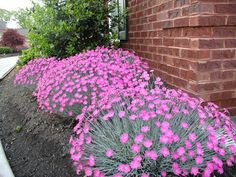The other picture is my favourite. On another early 20th-century front drive it shows another little cart on wheels, this time waiting to be pulled by two harnessed terriers. It is filled with the terriers’ four puppies.
Two well-dressed ladies are in attendance, one with a stick to guide the terriers and a look as if the puppy-cart had been her idea. It is a charming witness to a time when ladies did not have too much to do.
Since those halcyon days time has become money, but gardens have not slipped into economic marginality. Bradley-Hole cites a report from Oxford Economics in October 2018 on “The Economic Impact of Ornamental Horticulture and Landscaping in the UK” which credits them with sustaining nearly 600,000 jobs, adding £24.2bn to GDP and bringing in a further £2.2bn of spending by foreign tourists. 
I wonder how on earth they know those sums. Admittedly, a gatekeeper at Hidcote asked me last year if I could show my ID, but she was a charming Ecuadorean on secondment: without such checks how do we know the foreign spending?
However, the guesstimate is one to keep in mind during discussions about recharging the UK economy. Gardening can revitalise cities, north and south, and there is much more to be taught by employers than how to start a strimmer and use it while wearing earmuffs.
What is English about the English garden? Bradley-Hole presents a great variety, from cathedral and episcopal gardens to cottages and “water’s many moods”. She finds it predictably difficult to define a common Englishness, but believes that the strongest “unified thread” is the emotional connection that people have with their gardens. It exists, certainly, but in some of her choices it is complicated by the gap between the owners and the gardeners who actually do the work. At places like Wisley the owner is an institution, the RHS, which wants to draw and please as many paying visitors as possible.
I could easily select gardens that are “emotionally connected” with Greeks, French, Dutch, Italians, Germans and Japanese. The connection is not distinctively English.
The English climate is surely crucial. So is the historic absence of internal war and revolution since the 1640s. Nobody is calling for Sissinghurst garden to be “decolonised” and if they do, I will be out there in the South Cottage garden with a pitchfork to repel them.
One definite quality of English gardens is that they are not narrowly English at all. They are globally inclusive in their range and choice of plants. Their styles vary, but many of Bradley-Hole’s choices use clipped evergreen yew and box, basic building blocks whose formal use was learnt ultimately from Italy and France.
Many of their beloved roses are French in origin, as are many of their best forms of summer-flowering shrub. The wild floras of China and East Asia are crucial contributors.
The modern English garden is best at informality within a formal framework. It has been pursuing this ideal for more than a hundred years but its constituents have changed. Newly bred or newly found plants have multiplied the shapes and colours at a gardener’s disposal.
The seasons can now be prolonged far into November, whereupon winter gardening takes over, greatly enriched by Chinese and Japanese plants. The balance in the style tips to and fro, the formal green structure being more popular now than in the 1970s.

So-called wild gardening is fashionable but it has been around since at least the 1870s. However, as Bradley-Hole’s gardens well show, it tends to look best as one element in or beyond a formal setting. The Piet Oudolf garden at Hauser & Wirth in Somerset is not an English garden and, to my eye, its purple-pink colours and blocks of brown grasses prove the point.
Bradley-Hole’s 62 contain some usual choices but others I had never met before. The Robinsons’ garden at Ousden in Suffolk shows informal formality at its best, partly devised by Arabella Lennox-Boyd. The bold zigzag hedge of clipped yew looks superb. The Dutch-style Hilborough House in Norfolk was designed in the early 1990s by Francis Johnson and is admirably complemented by Arne Maynard’s brilliantly devised parterres of clipped box. Well-merited space is given to the National Trust’s fine restoration of Biddulph Grange in Staffordshire, a fascinatingly global garden with features echoing China, Japan, Italy and so forth. It is definitely one to visit.